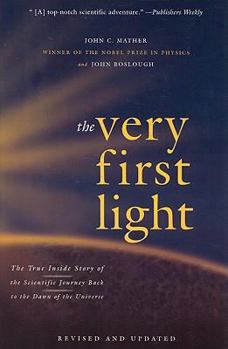The Very First Light: The True Inside Story of the Scientific Journey Back to the Dawn of the Universe
Select Format
Select Condition 
Book Overview
In a revised and updated edition, the story behind the most important cosmological finding of our generation.
Format:Paperback
Language:English
ISBN:0465005292
ISBN13:9780465005291
Release Date:September 2008
Publisher:Basic Books
Length:384 Pages
Weight:0.90 lbs.
Dimensions:1.0" x 6.1" x 9.0"
Customer Reviews
4 ratings
An Account of NASA's Shining Moment of the Last Twenty Years
Published by Thriftbooks.com User , 15 years ago
When first published in 1996, "The Very First Light" received a warm reception as a singular explanation for a non-technical audience of the work of the Cosmic Background Explorer (COBE). Most important, COBE's instruments provided data verifying the Big Bang theory of the universe's origins 13.7 billion years ago. John Mather led the science team that announced in 1992 that COBE had detected minuscule fluctuations in the temperature and density of cosmic background radiation, a microwave energy suffusing the entire universe that is generally considered a remnant, or "afterbirth," of the Big Bang. It was a stunning achievement, one for which John Mather of NASA's Goddard Space Flight Center shared the Nobel Prize in 2006 with George F. Smoot of the University of California. Mather, lead author of this book, is the first NASA scientist to receive the Nobel Prize. "The Very First Light" relates a history of COBE, its origins, approval, design and development, flight, and analysis of the results. It is a worthwhile examination of the process of big scientific pursuits in modern America, and both the priorities and the pitfalls of working in the confines of a bureaucracy where one is not free to pursue everything that might be desired. As one example, one member of the science team, decided to violate some of the strictures about group publication to pursue individual renown. At the center of this book is the question of how to design and build instruments to search for remnants of the Big Bang, now the standard explanation of how the universe originated. Mather and Boslough offer a useful short history of this effort, as background for COBE. The Big Bang theory's adoption came in the heady years following World War II when new technologies offered startling new scientific understandings. Using radio telescopes and advances in spectroscopy, scientists discovered that the uneven distribution of galaxies in the universe called into question other models of origination. Arno Penzias and Robert Wilson proved to be the critical scientists in collecting and interpreting this data, finding that background radiation existed in the cosmos and gaining the Nobel Prize in 1978 for this discovery. Others research followed. The most important was the effort of NASA's COBE satellite in the early 1990s, which discovered background radiation of varying densities clumped in various parts of the universe. These probably fostered the formation of galaxies, and through this connection Mather and others on his COBE science team were able to draw the connection between the Big Bang and the present universe. It mapped the distribution of matter across the sky, and discovered infrared and submillimeter background light, the possible faint emission from the first generations of stars and galaxies. COBE recorded how the radiant energy of the Big Bang gradually cooled and diluted as the universe expanded in all directions from the point of origin. Even so, it still fills t
Beautiful story of a major breakthrough
Published by Thriftbooks.com User , 17 years ago
The story of how mankind first came to understand what the microwave background describes is related. The first rate science done by the entire COBE team is a great example of what people are capable of. Mather's account of the COBE project and its science is a priceless account since he was the head scientist of the project. He writes about the cosmology as well as the instrument science in a very easy to understand way.
Very Informative..One of Best Scientific Journals I've read
Published by Thriftbooks.com User , 25 years ago
This is a great book. And every physicist, future-physicist, or any science lover should really read this book. One of best ways to get the brief summary of whole history of cosmology, while learning about the satellite that proves one of most famous theory we have in physics: big bang. I had borrowed this from library, and I loved it so much, I went ahead and bought a copy, and am in process of re-reading it. Really cool. Check it out!
If this one doesn't make you laugh and weep, I surrender.
Published by Thriftbooks.com User , 28 years ago
the very first light is a luminous book, filled with the joys and sorrows of physical experimentation at its best. This is some of the best science journalism I have ever read. I know some of the people so lovingly and painstakingly described: they are honest portraits, beaut- ifully rendered. The range of emotions runs the gamut: the highs, the lows, the trill of discovery, the constant re- trenching to make experimental packages of equiptment cheaper, smaller, cheaper, fool proof. This is one of the most human books ever written about scientists. Please, don't miss it.





